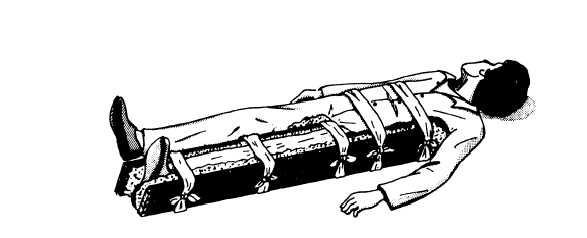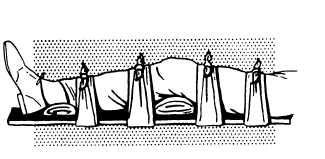present. A fracture just above the ankle is often mistaken for a sprain. If both bones of the lower leg are broken, an open fracture is very likely to result.

Figure 4-55.—Splint for a fractured femur.
If the fracture is open, stop the bleeding and treat the wound. Carefully straighten the injured leg. Apply a pneumatic splint if available; if not, apply THREE splints—one on each side of the leg and one underneath. Be sure that the splints are well padded, particularly under the knee and at the bones on each side of the ankle.
A pillow and two side splints work very well for treatment of a fractured lower leg. Place the pillow beside the injured leg, then carefully lift the leg and place it in the middle of the pillow. Bring the edges of the pillow around to the front of the leg and pin them together. Then place one splint on each side of the leg, over the pillow, and fasten them in place with strips of bandage or adhesive tape. Treat the victim for shock and evacuate as soon as possible. When available, you may use the Hare or Thomas half-ring traction splints.
Fracture of the Kneecap
The following first aid treatment should be given for a fractured kneecap (patella):
Carefully straighten the injured limb. Immobilize the fracture by placing a padded board under the injured limb. The board should be at least 4 inches wide and should reach from the buttock to the heel. Place extra padding under the knee and just above the heel, as shown in figure 4-56. Use strips of bandage to fasten the leg to the board in four places: (1) just below the knee; (2) just above the knee; (3) at the ankle; and (4) at the thigh. DO NOT COVER THE KNEE ITSELF. Swelling is likely to occur very rapidly, and any bandage or tie fastened over the knee would quickly become too tight. Treat the victim for shock and evacuate as soon as possible.

Figure 4-56.—Immobilization of a fractured patella.
Fracture of the Clavicle
A person with a fractured clavicle usually shows definite symptoms. When the victim stands, the injured shoulder is lower than the uninjured one. The victim is usually unable to raise the arm above the level of the shoulder and may attempt to support the injured shoulder by holding the elbow of that side in the other hand; this is the characteristic position of a person with a broken clavicle. Since the clavicle lies immediately under the skin, you may be able to detect the point of fracture by the deformity and localized pain and tenderness.
If the fracture is open, stop the flow of blood and treat the wound before attempting to treat the fracture. Then apply a sling and swathe splint as described below:
Bend the victim’s arm on the injured side, and place the forearm across the chest. The palm of the hand should be turned in, with the thumb pointed up. The hand should be raised about 4
